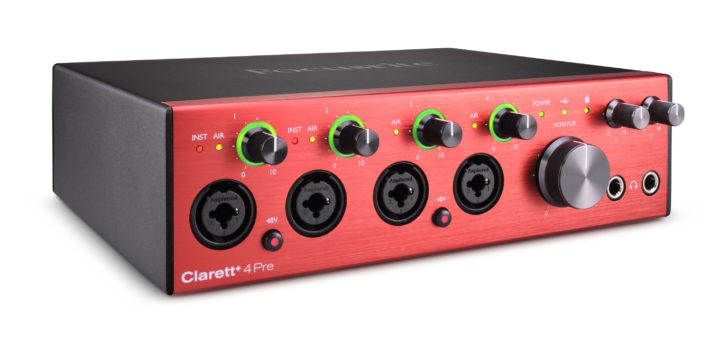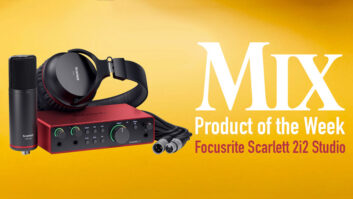
The Focusrite Clarett+ 4Pre is the mid-sized model in the latest version of the Clarett range, which also includes the 2Pre and 8Pre. Due to a shortage of converters, which resulted from a factory fire at the converter-manufacturer, AKM, Focusrite took the opportunity to redesign the entire line, Although it was an unexpected refresh, the end result, Clarett+, offers improved performance thanks to superior-quality Cirrus Logic converters. Besides offering expanded dynamic range and lower distortion, Focusrite beefed up the headphone amp in the revise.
As with its predecessor, you can control most of Clarett+’s functions with physical knobs and switches. However, you have to do all the routing and cue mix creation within the included Focusrite Control software (Mac/Windows/iOS).
HIGH ON I/O
The solidly built Clarett+ 4Pre is a metal-housed tabletop unit roughly 9 inches wide, 8 inches deep and 2.5 inches high. Like the previous Clarett line, it features a USB-C jack for connecting to your computer (USB-C is backward-compatible with USB 2.0). Both a USB-C to USB-C cable and a USB-C to USB-A cable (USB 2.0 connections) are included.
For its size, the 4Pre offers a surprising amount of I/O. Its eight analog inputs include four front-panel mic/line combo jacks and four additional ¼-inch TRS balanced line inputs on the back.
The unit also features a single Toslink ADAT optical input, allowing for eight additional inputs at 44.1 or 48 kHz, or four channels at 88.2 or 96k using a compatible mic pre unit. Two channels of S/PDIF I/O on RCA jacks round out the physical footprint. With all of its potential channels in use, you can have 18 simultaneous inputs. It also sports back-panel MIDI In and Out ports.
PreSonus MicroStation BT — A Real-World Review
Austrian Audio CC8 Microphone — A Real-World Review
Morton KickTone Microphone – A Real-World Review
HEADING OUT
On the output side, you’ll find four ¼-inch TRS connectors, all on the back. The front includes a pair of independently addressable ¼-inch TRS headphone outputs, each with its own volume control. The Headphone 1 output mirrors analog outputs 3 and 4.
Also on the front is a large Monitor gain knob, which controls Outputs 1 and 2 by default but can be reassigned in the Focusrite Control software. The front also features gain knobs for each of the four inputs, as well as two phantom power switches—one for channels 1 and 2 and another for 3 and 4.
You can switch the inputs for Channels 1 and 2 to accommodate instrument-level signals, but you have to do that in software. I’m not sure I get the logic of including physical phantom power switches on the front panel but not line/ instrument switches. I haven’t seen the inside of the unit, so it’s possible they just ran out of room. My guess is it was simply a design decision.
The input knobs for channels 1-4 are also used for input metering. They light up green to indicate signal present, orange when it reaches -6 dBFS and red when it reaches 0 dBFS. It’s similar to the little LED lights that many interfaces use, but the knobs are larger and easier to see. If you want more detailed meters, there is a corresponding page in Focusrite Control.
FOCUSRITE CONTROL APP
The Focusrite Control application plays a significant role in the 4Pre (and other Clarett+ units) workflow and is necessary for accessing certain features that are not accessible physically. I’ve tried a lot of interface control software, and I didn’t find Focusrite Control to be all that intuitive. However, once I was comfortable with its architecture, I was impressed with its capabilities, particularly in creating cue mixes.
Focusrite Control includes a selection of preset configurations for getting up to speed on the application. If you have trouble getting signals to come through or to be audible, choose a preset appropriate to your session. Not only will that solve your setup issues, but you’ll also see how the routing was configured.
The software includes separate windows for Inputs, Outputs and Settings (preferences). On the Output Routing page, the left side consists of a vertical row containing each available output pair. For the 4Pre, those include Monitor Outputs 1-2, Line Outputs 3-4 (which mirror Headphone 1, the first headphone output), Headphone 2 and S/PDIF.
If you have an external headphone amp, a S/PDIF device with headphone outputs, and a couple sets of headphones, you could send a different stereo mix to each output pair. You could also split any of the output pairs into a pair of mono mixes.
Focusrite Control displays separate sliders for the input and DAW return when you create a mix, which you can balance to taste. The input signal is pre-DAW, so it has virtually no latency. Each output pair is set by default to monitor the main output from your DAW (1-2), but you can also set it to monitor the other output pairs.
That makes it possible to send different monitor mixes to each output of the 4Pre if you set them up using aux sends in your DAW. But for most monitoring situations, you’ll probably be fine balancing the input level against the return of the DAW’s main mix.
I used both the Mac and iOS versions of Focusrite Control. The Mac version was very stable. The iOS app, which relies on Wi-Fi to communicate with your computer, has a well-designed user interface and comes in handy as a monitor controller because it includes Mute and DIM switches, as well as level controls.
On the downside, I found its ability to connect to the hardware a bit finicky, and it lost its Wi-Fi connection several times while in use, even though it was less than three feet from my Wi-Fi router.
AIRING IT OUT
Like the previous range of Clarett interfaces, the Clarett+ 4Pre (and the other Clarett+ models) features a setting called Air, designed to emulate the sound of the ISA 100 mic preamps from the revered Focusrite Studio Console (designed by Rupert Neve). You can turn Air on and off for any of the 4Pre’s preamps in Focusrite Control. The Air circuitry has been upgraded for the Clarett+ line, and it’s now on par with Focusrite Pro’s Red interfaces.
The mic preamps in the 4Pre are clean and neutral without the Air. When you switch it on, the sound becomes brighter and more shimmery. You might have to de-ess vocals more in recordings made with Air, but they’ll have an excellent open, “airy” sound to them.
In addition to use on vocals, Air’s effect was particularly noticeable on instruments with significant transients, such as acoustic guitar and mandolin. Drums? Of course, but with taste and where needed.
TESTING, TESTING
During the review period, I used the 4Pre with two different computers. One was an older Mac Pro, which I connected with the USB-C to USB-A cable. The other was a relatively recent 16-inch MacBook Pro, which has Thunderbolt 3 ports that are backward-compatible with USB 3.0.
The interface worked fine with both computers, but when I connected it to the MacBook Pro, the speed and bandwidth of USB 3.0 were much more impressive. I could comfortably open a lot more tracks and plug-ins than on the Mac Pro, which I had to connect using USB 2.0.
The Clarett+ interfaces all come with a generous software bundle that includes such titles as Ableton Live Lite, Amplify Studio, Antares Auto-Tune Access, XLN Audio Addictive Keys, XLN Audio Addictive Drums 2, Relab LX480 Essential, Softube Marshall Silver Jubilee 2555, brainworx bx_oberhausen, brainworx bx_ console, Focusrite SC, Focusrite Red Plug-in Suite and brainworx bx_masterdesk.
In sum, the Clarett+ 4Pre gives you a great deal of I/O, potential I/O functionality and solid sound quality for the money. Its small footprint and expandability make it perfect for a personal or home-based studio. If you have a Thunderbolt 3 or USB-C computer, in particular, you’ll love the performance.
I didn’t have a Clarett interface to compare to the Clarett+, so I can’t say how much better the new converters sound, but the specs are better, and I liked what I heard. Focusrite did an excellent job turning an adverse situation with one of its suppliers into a new-and-improved range of interfaces.







